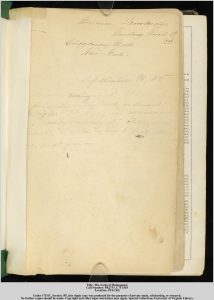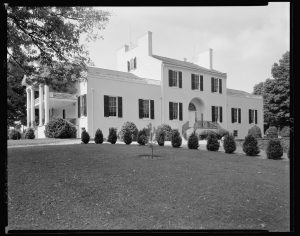Editor’s note: Although Book Traces @ UVA has officially concluded our surveying project that was supported by a CLIR Cataloging Hidden Collections grant, we are delighted to see ongoing interest in the uniquely modified books we’ve discovered. Here we present a new guest post by Jamie Rathjen.
Alderman Library holds a sizable collection of books donated in 1949 by alumnus Frank C. Littleton (1873-1951) which belonged to him and his wife, H. Olive Trowbridge (1883-1924). Two of those that are most heavily written in were used by Olive’s aunt and caregiver Miriam Trowbridge Osborn (1840-1891) in her time at a private girls’ school, referred to in her inscription as “l’ecole de Madam Chegary,” in New Jersey and possibly New York. In the two volumes, a book of Robert Burns’ poetry and of Oliver Goldsmith’s poetry, plays, and essays, young Miriam combines an embrace for superlatives (both positive and negative) in response to her readings with at times pithy observations from the school’s English professor, Rev. Joseph McKee, about the poets themselves.
Miriam writes on the inside cover of the Burns book, “Mr McKee believed that Burns with all his love for drink and festivity was truely [sic] a pious man. Byron was a bad man.” The school was founded by a French immigrant, Heloise Chegary (1797-1889), and seems to have been notionally Catholic; that is, writer Emma Benedict Knapp, who was from the area and briefly attended the school as a child, noted that her “blue Presbyterian” father respected Chegary for “her methods of education and discipline” and regardless sent his children there (12). We see then from Miriam’s first note an almost immediate subtext focused on morality; at the end of “Epistle to a Young Friend,” the first poem substantially marked, she writes in her typical style “the morality of this poem is beyond all praise.” Later in the book, Miriam notes “a horrible satire” at the beginning of “The Holy Fair,” one of Burns’ famous satires on the organized religion of his day. (Burns’ other well-known satire about a preacher, “Holy Willie’s Prayer,” is not marked at all.) In another poem, “The Ordination,” Miriam again marks one stanza with “satire.” It is as if McKee, or Miriam, wants to make very clear that any time Burns writes about religion it must on some level be a satire. Yet McKee seems to have held Burns in very high regard: “We learn more in three stanzas of Burns than we would in all of Scott’s works,” Miriam records him as saying.
Miriam recorded her notes in Madam Chegary’s school at a time when it was transitioning from northern New Jersey to a new location in New York City and when she herself was transitioning to adulthood. She records a few specific dates (including “Oct 15th 1855” in the inscription) in the Goldsmith book, but only one in the Burns book. This gives no hints as to at which location she was, but Knapp writes that when she attended at the age of seven ca. 1854-55 the school was already at its New York location: “the southwest corner of Twenty-eighth Street and Madison Avenue – two houses” (12).
Another example of Miriam’s sarcastic streak is a wry note at the beginning of the Burns poem “Despondency: An Ode,” which contains such lines as “My woes here shall close ne’er / but with the closing tomb!” at the end of the first stanza. Responding to this, Miriam writes “September 26 1855. On the departure of Mother – quite apropos,” underlining the entire first stanza and placing her trademark non-verbal notes – large parentheses – around all of the stanzas in turn. Besides the date given, some of the notes function as a rough time capsule of the period: for example, a reference to “forty pounds” in Goldsmith’s “The Deserted Village” is marked with “$200,” revealing that five dollars to one pound was an approximate exchange rate at the time. On the same page, Miriam writes “Mr McKee says that any young man with a good education can repeat this passage,” referring to the then-common practice of memorizing poems as part of one’s education. At the beginning of the Burns poem “Halloween,” she explains the title holiday as “the night before the first of November,” in the era before it was commonly celebrated in America. Yet Miriam grew up rather quickly after writing in these books: another book of hers at UVa is a volume of Shakespeare in which she initially wrote in the spring of 1855, and then again on what she describes as the “dreadfully cold and inclement” night of 15 September 1856. “I wonder where I shall be at this time next year,” Miriam muses. Her words proved to be fitting: in 1858 she married Charles J. Osborn (1837-1885), who became a prominent Wall Street broker, and then had a son, Howell (1859-1895).
“Announced on this 16th of October 1855. There is no author who writes the English language with more purity than Goldsmith.” Thus Miriam inaugurates her annotations of the Irish author, beginning with his poem “The Traveller.” The relatively long poem shows a broad cross-section of Miriam’s notes, beginning with those which are most common, such as simply “very fine” or “beautiful.” There are also those for reference which divide the poem into sections for the different countries visited, as well as Miriam’s idiosyncratic way of defining strange words: a small X or cross is placed above the word, and another of the same is placed in the margin next to the definition. For example, in “The Traveller,” the river “famed Hydaspes” is given as “the boundary of Alexander’s conquests in the East.” This is the only example for an allusion, though; the other two in the Burns book explain words of dialect. Finally, Miriam also reflects on the poem: “this shows that happiness is equally distributed throughout all nations,” and then on the same page “the final lines,” a reference to what can be found written below the end: “True happiness is found within ourselves.”
Miriam’s description of Goldsmith inside the front cover of the book shows a man accustomed to opulence yet generous in the extreme, resembling yet exceeding what Miriam would become as an adult:
“Goldsmith had a great passion for dress. Sometimes he was beautifully dressed, at other times he looked very slovenly. One would not take him for the same man. He made from 5 to 6 thousand dollars a year, and still sometimes he had to borrow a shilling to buy his dinner. He was very extravagant and exceedingly generous. As long as he had anything, no one wanted if he could help it. He never was married, but when he died he was in debt 10 thousand dollars.”
Overall, less of the Goldsmith book is marked than Burns, in part because the final 400 pages or so contain his two plays (The Good-Natur’d Man and She Stoops to Conquer), only the former of which is substantially marked, and his essays. Miriam sees parallels between Honeywood, the titular good-natured man, and the author: “no one but Goldsmith,” she writes next to his name in the dramatis personæ. Later in the play, Honeywood is under house arrest and gets to talking to the bailiff that is looking after him. The dim-witted bailiff tries to sound smart by, among other ways, putting “among us that practice the law” at the end of some of his sentences. “The bailiff tries to be literary,” Miriam writes as the smooth-talking Honeywood proceeds to bribe him. “How soon the money changes his deportment towards him,” Miriam notes sarcastically. Turning to She Stoops to Conquer, Miriam declares “this play is the most laughable in our language” on its very first page; “laughable” is something that she calls the play and a number of lines and poems in both books, and, since She Stoops to Conquer is a comedy, it is unclear if she means “humorous” or “contemptible.” Regardless, she seems to have enjoyed at least The Good-Natur’d Man: ironic, given events that were to transpire in her later life.
The books’ ultimate connection to UVa is that Miriam’s niece Henrietta Olive Trowbridge (frequently called Olive, while she later seems to have herself gone by H. Olive) came into her care following the deaths of both of her parents in 1883: her mother in childbirth, and her father, Miriam’s brother Clement J. Trowbridge, through disease. Miriam was “extremely fond” of Olive compared to her son Howell, who developed a hedonistic, luxurious lifestyle not dissimilar to the “very extravagant and exceedingly generous” habits Miriam described of Goldsmith, so it is perhaps no surprise that Olive ended up with her books (The Osborn, 27). During this period, the family lived at Tahoma, the imposing Osborn estate in Mamaroneck, N.Y. built by Miriam’s husband Charles in the years before his death in 1885; Miriam died when Olive was only eight years old, and the family’s lawyer, John Sterling, became her guardian. Olive ultimately spent most of her life at Tahoma; she and her husband, Frank C. Littleton, only moved out in 1922 in favor of Oak Hill, the one-time residence of President James Monroe in Aldie, Va. Even though Olive’s death came in 1924, soon after they moved, and Miriam’s books were not donated to UVa until 1949, Olive is listed first on the bookplates and Oak Hill is mentioned as well.
The Osborns seem to have mixed with the very upper crust of New York; the family also owned a home on Fifth Avenue which was regarded in the New York Times as “one of the most substantial houses in the fashionable part of the city.” Charles Osborn made his fortune by pushing around the money of wealthy industrialists such as J.P. Morgan and especially infamous railroad baron Jay Gould, with whom the Times readily admitted Osborn was not friendly and contrasted greatly: “as open-hearted, generous, and cordial as Gould was narrow, irresponsible, and selfish.” At his death, the elder Osborn could nevertheless consider himself well-regarded in his industry.
Miriam’s son, Howell, became a successful young broker in his own right, but after his father’s death the “jaunty, gay, and reckless” son inherited an $35,000 annual income (equivalent to more than $820,000 today), which allowed him to quit brokering. He maintained an apartment in Paris where he was noted for his “lavish hospitality,” outwith his generosity. The Times reports an anecdote of the latter: a rich man from Baltimore enlisted a florist to buy an orchid from the Osborn estate for $2500. Howell seemingly refused to sell; the next day, he delivered a package containing the orchid to the florist, entreating the other man to make his employer “pay big” for it. “What he wouldn’t sell he gave away,” observes the newspaper. Ultimately Howell’s substantial income, which only increased after Miriam’s death, was not enough for his tastes. The Times writes of him that (emphasis added):
“Mr. Osborn’s name was prominently before the public for many years because of his fondness for the stage, his debts, and his mother’s determination to prevent, as far as possible, any actress from receiving any benefit from her estate.”
By this period, and perhaps because of Howell, Miriam had developed an intense, specific distaste for actresses. An anecdote repeated in Howell’s Times obituary, among other places, claims that Miriam attempted to exclude from her estate any children that Howell would have with an actress. Regardless Howell, while indeed cohabiting with actresses including future Broadway star Fay Templeton, never had any children. Miriam’s niece Olive then became the beneficiary of Howell as well as Miriam, a fact affirmed by the New York court system when Miriam’s two sisters attempted in a series of 1898 suits to get two-thirds of the estate for themselves and leave one-third for Olive. They failed to give sufficient grounds to invalidate Miriam’s will; thus, the 15-year-old Olive had become rather quickly the last Osborn scion.
Miriam’s enduring legacies are two buildings that she had constructed with the family fortune: one she envisioned as a retirement home for women in suburban New York, and a donation, in the memory of her husband, in the form of a lecture hall to Yale University. Neither exists in quite its original form; the retirement home seems to have dropped the women-only designation, while the Yale building, close to several of the university’s science departments, is now primarily laboratories. However, both retain the Osborn name to this day: “The Osborn” and “Osborn Memorial Laboratories,” rather than the original “Osborn Recitation Hall.” An article in, ironically, the Harvard Crimson describes the recitation hall as sumptuous and advanced, and sure to be “one of the finest buildings belonging to the college.” The retirement home was not opened until 1908, well after Miriam’s death, but came to include Olive on its board of managers at one point – its only actual connection to a living Osborn (The Osborn, 27). Instrumental in both buildings was the family’s longtime lawyer, John Sterling, a Connecticut native who possessed the connection to (and two degrees from) Yale and acquired the land for the retirement home, as well as performing other functions for the family such as serving as a guardian for Olive after Miriam’s death. The Osborns built their fortune through the investment world, but the family’s legacy was secured as much through philanthropy as any business transaction.
Miriam’s prescient words appear one more time in “Epistle to a Young Friend,” as she notes at the end of the poem “Burns was the most sociable being living. So much so that he was sought by everyone, that is where he got the habits that were the bane of his life.” While reacting sympathetically to the Scot, the same words could later plausibly describe her own son. It is appropriate that Miriam declares that one can find “humanity in Burns’ every image,” because that seems to be what she enjoys most about both books of poems – or, as she records someone else from the school putting it, “blessed be the Poets, for they have taught us to be human.”
Works Cited
Hun, Marcus R., ed. “Henriques v. Trowbridge.” Reports of Cases Heard and Determined in the Appellate Division of the Supreme Court of the State of New York. Vol. XXVII (1898), 18-22. Albany: Banks, 1898. https://books.google.com/books?id=g4ELAAAAYAAJ
Knapp, Emma Benedict. Hic habitat Felicitas: A Volume of Recollections and Letters. Boston: W. B. Clarke, 1910. https://archive.org/details/hichabitatfelic00knapgoog
Zwerger, Mark R., et al. Images of America: The Osborn. Charleston, S.C.: Arcadia Publishing, 2008. https://books.google.com/books?id=gYjaw-xod6AC
Death of Charles J. Osborn. The New York Times. 12 Nov. 1885. (accessed on ancestry.com)
Good-Bye to Wall-Street: Howell Osborn is Going to Stop Speculating. The New York Times. 13 Sep. 1886. (accessed on ancestry.com)
Howell Osborn Dead. The New York Times. 7 Feb. 1895. (accessed on ancestry.com)
The New Recitation Hall at Yale. The Harvard Crimson. 5 Dec. 1889. www.thecrimson.com/article/1889/12/5/the-new-recitation-hall-at-yale/.
Poems, Plays, and Essays, by Oliver Goldsmith, M.B. Boston: Phillips, Sampson, and Co., 1855.
The Poetical Works of Robert Burns. Boston: Phillips, Sampson, and Co. 1855.






